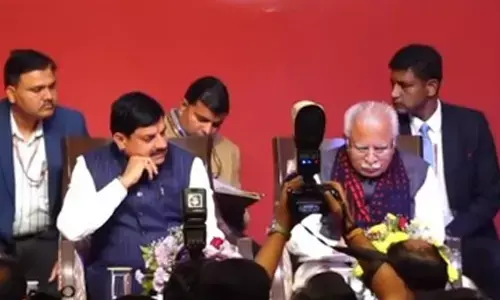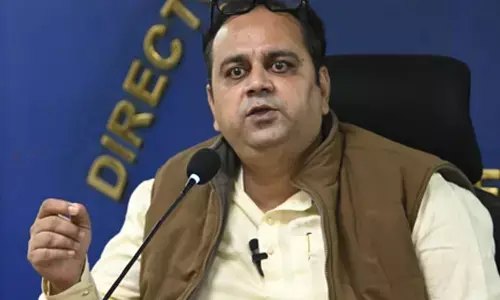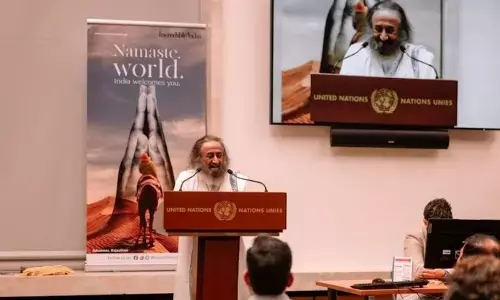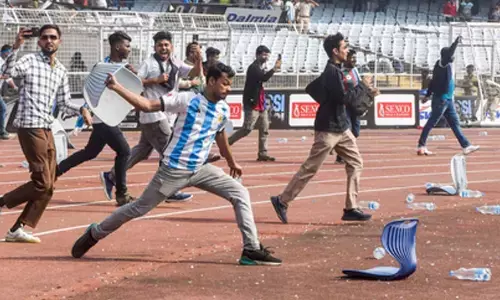Of shrinking space and swelling traffic
 Of shrinking space and swelling traffic
Of shrinking space and swelling trafficFor some strange reason this columnist remembers a number that pertains to two totally unrelated things, about the time his parents first came to Hyderabad in 1954. One, that the twin cities had an area of 36 km² and, strangely enough, that there were 36 cinema halls in them!
Be that as it may, what one certainly remembers distinctly is the very spacious feel of the city, its broad roads, the speed with which one moved from one part of the city to another and, definitely most of all, the freshness of the air. Yes, this was probably true of most cities at that time, not only in India but elsewhere in the world.
The idea, this week, is to take a close look at the problems relating to the transporting of goods and persons from place to place, at the issues involved, and to suggest measures to address them satisfactorily. Transportation essentially involves efficient movement of people and goods and touches all aspects of life such as economic development, quality of life, equity, public health and ecological sustainability. It is not to be seen, especially in urban areas, as an end in itself but, rather, as an investment tool to help cities achieve larger objectives.
A matter of great concern around the world, over the last several decades, has been the increasing concentration of populations in metropolises. There has, as a result, been a range of issues thrown up relating to putting in place economic infrastructure such as transport, housing, power, water supply, and social infrastructure such as housing, education and medical/health facilities.
The local authorities and the governments have, consequently, faced several challenges including finding the funding required, as well as dealing with the consequences of growth and development, such as the increasing demand on energy, air and noise pollution and the possibility of accidents. All issues not unfamiliar to the Hyderabadi! Even at the best of times, mobility is an issue and, come the monsoon, the site of marooned vehicles and drain water gushing over breached roads greets one every other day.
Granted, the civic authorities and the State government have their hands full with several challenges and complicated issues. It cannot be forgotten, after all, that the population of the country has grown over 41/2 times and the number of vehicles increased close to more than 150 times over the past several decades.
Why, in Hyderabad city itself, statistics show that the number of motor vehicles has increased from 1.36 million in 2004 to 2.37 million in 2016. The consequent demand on funds, and men and material, on the authorities concerned needs to be appreciated.
The point is that, given a certain amount of determination in demanding for, and securing, coordination between and among the various agencies concerned, and observing a modicum of restraint in expenditure in order to fund priority areas, the task is not beyond their ability. We should not forget the words (attributed variously to John F Kennedy and Henry Ford) – "America is rich because its roads are good; but not that its roads are good because America is rich."
Many countries have experimented with taxes and cesses on motor vehicles, petroleum products and the like partly in order to raise the funds required for roads and also with a view to discouraging excessive use of private motor vehicles. In this context we need to note that public transport accounts only for 27% of urban transport in India compared to 49 in Philippines, Venezuela and Egypt, 40 in South Africa, South Korea and Brazil, and 62 in Bogota.
Congestion in large cities is on account of many reasons, not the least of them being the fact that establishments that attract large numbers of clients/customers, such as hospitals, educational institutions, starred hotels and malls et cetera are usually located in inappropriate or unauthorised places without adequate inbuilt provision for parking of motor vehicles. Those who have lived in Delhi will recall the painful eyesores of five-star hotels in the heart of Lutyens Delhi.
As one of the measures of facilitating easy and comfortable travel by public transportation for commuters major cities across the world have attempted an integrated ticketing arrangement. In London, for instance, there is the instrument called an 'oyster' which doubles up as a ticket for bus and rail travel.
Hong Kong does one step better, and its 'octopus' serves not merely these two purposes but can also be used as a credit card! Then, many of the metropolises in the world such as New York, London, Tokyo and Mumbai, to mention but a few, have well-maintained footpaths (even in non-– arterial streets) and bus bays the use of which is compulsory.
Other measures to discourage speeding and make for the safety of pedestrians, as well as commuters Include separate lanes for different types of vehicles, for different speeds and also exclusive corridors for emergency services such as ambulances and fire engines. Some of the environment – friendly measures now becoming increasingly popular include park – and – ride arrangements, especially in walled colonies.
Motor vehicles are stopped outside and guests provided electric trolleys for movement inside. Fairs and amusement parks also use this facility.Roads in our country are usually constructed and maintained by the authorities at various levels such as the panchayat/municipality, the State governments and the Central government.
Since it is the Central government which has the largest resources available for maintenance, followed by the State government, efforts are often made for roads to be transferred from the local authorities to the State governments and the State governments to the Centre. This often results in the Central government being saddled with more road length than it can manage efficiently even with its generous allocations.
Clearly the time has come for the country to realise the necessity of raising the level of public transportation in the agenda of the governments at the national, State and local levels.
Many measures will need to be taken in the future including innovative methods of raising the requisite funds, exploring contemporary arrangements such as the public – private – partnership models, diversifying public transport into hitherto make collected areas like underground railways, hydro foils in coastal cities, expended use of inland waterway with its infrastructure already in place, consciously promoting the coming of satellite cities/towns like LB Nagar, Kukatpally and Rajendranagar etc. in Hyderabad.
The National Urban Transport Policy 2014 envisages, as part of its vision, growth of urban transport on a low carbon path. Among the objectives of the policy are the incorporation of urban transport and important parameter at urban planning stage rather than being a consequential requirement, and the bringing about a more equitable allocation of road space with people, rather than vehicles, as its main focus.
The policy also dwells at length on measures of promoting non-motorised transport. While the policy mentions several methods of financing public transport, using land as a financial resource is one innovative method that finds place in it.
The policy also notes the absence of legislation that covers the requirements of urban transport comprehensively and states that the government of India will address the need for enacting comprehensive legislation to cover all aspects of urban transport in the future. Perhaps this will be the instrument that will prove to be the "final solution"!
The trends and prospects of urbanisation and motorisation in India suggest that if one were to be content with the business as usual approach, the unfolding scenario presents a deadly if not frightening, picture.
(The writer is former Chief Secretary, Government of Andhra Pradesh)










